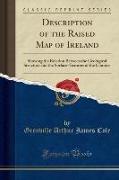- Start
- Description of the Raised Map of Ireland
Description of the Raised Map of Ireland
Angebote / Angebote:
Excerpt from Description of the Raised Map of Ireland: Showing the Relation Between the Geological Structure and the Surface-Features of the Country
In the south-east of Ireland there is a series of slates and quartzites, resulting from the hardening of old muds and sand stones, which now forms the promontory of Howth and the broken country south of Bray. The two Sugarloaves of co. Wicklow are due to the resistance of beds of quartzite to the general weathering, which has worn away the slates more easily. The same type of rock appears again south of Wexford town. Though no conclusive fossils have been found in this series, the evidence is strongly in favour of a cambrian age.
Close against this series, along both sides of the Leinster Chain, shales and sandstones occur, containing in a few places Silurian fossils. The division between the lower and upper silurian systems (which are also Called by many writers ordovician and silurian respectively) is very uncertain in many parts of Ireland, and the colours on the map will probably require modification as time goes on. But this point is of little importance, if we regard the two systems as forming a continuous mass of strata, characterised towards the top by distinctly later forms of life than those which prevail in its earlier horizons. The Silurian sea - using the name Silurian for both systems - must have spread over practically the whole Irish area, since patches of its deposits appear, surrounded by younger strata, in a great number of places where weathering has worked sufficiently far down. A broad Silurian area forms the hummocky country from Longford north-eastward through Cavan, Monaghan, Armagh, and Down, a region of small hills of slaty or sandy rock, with a tendency to form stiff s'oils. Numerous volcanic eruptions took place in Lower Silurian times in the region of the Leinster Chain and in Connemara. A small volcano of Upper Silurian age has left relics in the west of the Dingle Promontory, where its lavas and ashes are inter bedded with fossiliferous strata.
About the Publisher
Forgotten Books publishes hundreds of thousands of rare and classic books. Find more at www.forgottenbooks.com
This book is a reproduction of an important historical work. Forgotten Books uses state-of-the-art technology to digitally reconstruct the work, preserving the original format whilst repairing imperfections present in the aged copy. In rare cases, an imperfection in the original, such as a blemish or missing page, may be replicated in our edition. We do, however, repair the vast majority of imperfections successfully, any imperfections that remain are intentionally left to preserve the state of such historical works.
Folgt in ca. 5 Arbeitstagen
